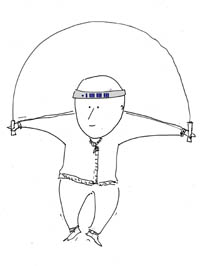Nicola Richards (a fabulous PE educator in Christchurch) and I recently co-authored the latest SOLO resource – this one supports teachers charged with helping students think more deeply in movement contexts in physical education. Our typescript has gone to the publishers but the ideas around movement contexts remain firmly lodged in cracks and crevices in my mind.
Given that my involvement in challenging movement contexts is largely limited to negotiating Auckland central city bus lanes in peak hour traffic on Symonds St, I picked up a lot of new ideas when researching this book – ideas about touch rugby, fitness cardio work outs and gymnastics to name a few.

It started me thinking about the sort of cognitive workout you would get when you think across each level of SOLO Taxonomy.
I often talk about the change from quantitative to qualitative outcomes when a learning outcome shifts from SOLO unistructural and multistructural outcomes to relational and extended abstract outcomes but you only need to read Biggs & Collis (1982) and Hattie & Brown (2004) to appreciate that the cognitive workout involved, when moving across SOLO levels, is much more nuanced.
Caution: We note that none of the SOLO cognitive workouts described below should be attempted without wearing a professionally fitted SOLO brain band.
Cognitive workout #1: Enhancing cognitive capacity.
Step One: Start small by asking your brain to name, list, label, match, define and or describe Thing 1. The demand on working memory is small at the SOLO unistructural and multistructural level – but even so depending on what you were up to last night you may need to use recall strategies like repetition, imagery or pattern to help you encode the information and answer the question.
Step Two: Now crank up demand on your working memory by thinking at a SOLO relational level about Thing 1. Attempt to put what you know into a time line (sequence) – look for similarities and differences with Thing 2 (compare and contrast) – explain what caused Thing 1 or what effect it will have (causal explanation) – break Thing 1 into bits and figure out how the bits contribute to the whole (analysis). Simple recall will not be sufficient – at the SOLO relational level you will have to use extra working memory to increase your attention span – you may experience some discomfort due to the cognitive stretch from thinking about the links or connections between the information.
Step Three: Not recommended for the morbidly un-thoughtful – and aspirational on your first working memory workout – but those who regularly think in the liminal zones might like to try thinking about Thing 1’s linked ideas in new ways – to make generalisations, predictions and evaluations about Thing 1.
Feel that working memory burn.
Detail of future cognitive workouts can be seen below. They will involve:
• enhancing the relationship between the question asked, and the answer given.
• balancing the need for closure against the need for consistency, and
• building simple and complex structure with pieces of information.
References
Biggs, J.B., & Collis, K. F. (1982). Evaluating the quality of learning: The SOLO taxonomy (structure of the observed learning outcome). New York: Academic Press.
Hattie, J. A. C., and Brown, G.T.L. (2004). Cognitive processes in asTTle: The SOLO taxonomy. asTTle Technical Report (No.43). Auckland: University of Auckland and the Ministry of Education.





{ 1 comment… read it below or add one }
I hadn’t heard of the SOLO model of learning until I spoke to Nicola last weekend. I am considering using these ideas to improve my teaching of Bridge at the local Bridge club.
{ 1 trackback }